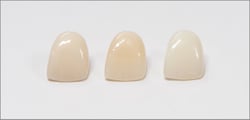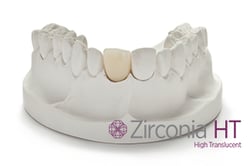Since its emergence into the dental arena, Zirconia has increasingly become the material of choice for clinicians who wish to provide their patients with the most technologically advanced metal-free restorations.
Zirconia has improved significantly by introducing a more comprehensive array of available milling pucks, allowing for more significant shade variation and translucencies that closely resemble natural dentition. In addition to improved esthetics, the Zirconia physical properties allow for durability, strength, and precision-fitting restorations. To maximize the success of seating Zirconia restorations and to minimize chairtime, it is essential to ensure proper preparation guidelines are followed.

Why tooth preparation design is important
- Smooth edges result in lower stress on the crown. This lower stress decreases the percentage of fractures occurring.
- Ceramic restorations require a passive fit.
- Uniform reduction results in excellent ceramic strength.
- Sufficient reduction leads to the best aesthetic results.
- Digital scanners read smoother preparations with more accuracy.
Preparation guidelines for an anterior zirconia crown
 When prepping a tooth for an anterior Zirconia crown, you will need to ensure sufficient room for the wall thickness to have a minimum of 0.3 mm and ideally between 1.0 mm and 1.5 mm, or 1.8 to 2.0 mm incisal reduction.
When prepping a tooth for an anterior Zirconia crown, you will need to ensure sufficient room for the wall thickness to have a minimum of 0.3 mm and ideally between 1.0 mm and 1.5 mm, or 1.8 to 2.0 mm incisal reduction.- There should be a visible and continuous circumferential chamfer with at least a 0.5 mm reduction at the gingival margin.
- The horizontal and vertical preparation of the tooth should have an angle of approximately 5°, and a bevel is not advisable.
- All the incisal edges should be rounded, and the lingual aspect of the anteriors should be reduced with a football diamond to create a concave lingual.
Preparation guidelines for a posterior zirconia crown
- When prepping a tooth for a posterior Zirconia crown, you will need to ensure sufficient room for the wall thickness to have a minimum of 0.5 mm and ideally between 1 mm and 1.5 mm or 1.5 to 2 mm occlusal reduction.
- The prep should be tapered between 4°and 8°. It will also need to have a visible and continuous circumferential chamfer, and a reduction of at least 0.5 mm is required at the gingival margin.
- Just as with the preparation for an anterior crown, a bevel is not recommended. Ensure that all occlusal edges should be rounded.
- Shoulder and Chamfer preparations are ideal for zirconia. Feather Edge preparations are not recommended but can be acceptable for full-Zirconia crowns. Check with your dental laboratory to see if their fabrication process will allow for this prep form.
Factors that may make a crown preparation unacceptable for a zirconia restoration
- To be acceptable for a Zirconia crown restoration, the preparation should not have any undercuts, and it should not have a gutter preparation.
- Both 90° shoulder and parallel wall preparation are unacceptable.
- Sharp incisal or occlusal edges are not suitable for a zirconia restoration.
Layered or monolithic restorations
For restorations within the aesthetic zone, a Zirconia crown layered on the facial or full layering will provide optimal results. Over the past few years, layering porcelain techniques have improved significantly. Hence, a Zirconia substructure that has been layered with porcelain is unlikely to chip or fracture on the occlusal or incisal.
 However, suppose maximum strength is required because a patient has bruxism, a heavy bite, or where there is only limited occlusal clearance. In that case, a monolithic crown may be a better posterior solution. Thanks to newer monolithic zirconia (single, solid blocks of zirconia), this crown is nearly unbreakable and built to withstand the harsh environment the posterior of the mouth endures better than all-porcelain crowns. Monolithic restorations provide an increasingly aesthetic result with the introduction of High Translucency Zirconia or the DDS Lab product reference, Zirconia HT.
However, suppose maximum strength is required because a patient has bruxism, a heavy bite, or where there is only limited occlusal clearance. In that case, a monolithic crown may be a better posterior solution. Thanks to newer monolithic zirconia (single, solid blocks of zirconia), this crown is nearly unbreakable and built to withstand the harsh environment the posterior of the mouth endures better than all-porcelain crowns. Monolithic restorations provide an increasingly aesthetic result with the introduction of High Translucency Zirconia or the DDS Lab product reference, Zirconia HT.
- There should be a 1.0 to 1.5 mm occlusal depth cut for a full-contour monolithic Zirconia crown to achieve appropriate occlusal anatomy.
- You will need to ensure a 1.0 to 1.5 mm functional cusp tip reduction, a 0.5 mm gingival chamfer reduction, a 6 to 8-degree taper to the axial walls, and a 1.0 mm occlusal 1/3 reduction of the functional cusp.
- Prepare a 0.3 to 0.5 mm chamfer for the marginal design to allow for a more accurate mill of the pre-sintered zirconia.
Cementing and finishing zirconia restorations
- Quite often, marginal finishing is required when fitting and cementing Zirconia restorations.
- Excess cement must be removed to avoid plaque formation, leading to tooth sensitivity and periodontal disease.
- Gingival margins can be finished using non-cutting, safe-end finishing burs that will protect the soft tissues.
Although these adjustments may slightly roughen the surface of a Zirconia restoration, it should be easy to polish, creating an exceptionally smooth surface.
If adjustments are required, it is essential to use a fine diamond bur suitable for a Zirconia restoration. Too much heat or sparking from an aggressive reduction will lead to micro-fractures in the Zirconia. It is essential to use as little pressure as possible to reduce the amount of heat produced. Using water while adjusting is also helpful to keep the restoration cool.
Please be reminded that should you wish to discuss a Zirconia implant case in more detail, our experienced technical team is here to assist you.
Click here to schedule a consultation with our technical team ›
